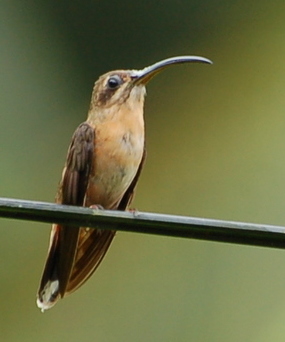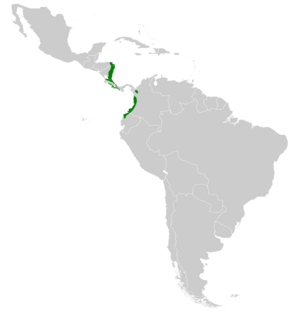Bronzy hermit facts for kids
Quick facts for kids Bronzy hermit |
|
|---|---|
 |
|
| Conservation status | |
| Scientific classification | |
| Genus: |
Glaucis
|
| Species: |
aeneus
|
 |
|
The bronzy hermit (Glaucis aeneus) is a cool type of hummingbird. It belongs to the Trochilidae family. This amazing bird lives in Central and South America. You can find it in countries like Colombia, Costa Rica, Ecuador, Honduras, Nicaragua, and Panama.
Contents
What is a Bronzy Hermit?
How Scientists Classify This Bird
The bronzy hermit is a close relative of the rufous-breasted hermit. Scientists once thought they were the same species. Now, they are seen as very similar but separate. The bronzy hermit itself is considered one single species. Even though it lives in different areas, it's not split into smaller groups.
What Does the Bronzy Hermit Look Like?
The bronzy hermit is a small bird. It is about 9 to 10 centimeters (3.5 to 4 inches) long. Males weigh between 3 and 6.5 grams. Females are a bit lighter, weighing 3 to 6 grams.
Both male and female bronzy hermits look quite similar. Their upper parts are a shiny bronzy or coppery green. Their throat and chest are a deep buff color. Their belly is a lighter buff. They have a dark face with a clear white "moustache" stripe.
The top of their tail is gray-green with white tips. The underside of the tail is reddish near the body. It then turns blackish in the middle, with white tips.
Differences Between Males and Females
Male bronzy hermits have a bill that curves downwards. The top part of their bill has tiny saw-like edges. Female bronzy hermits have a bill that curves even more. Their bill does not have the saw-like edges.
Small Differences by Location
Bronzy hermits from Central America have slightly longer wings. However, their feathers look exactly the same as those from South America.
Where Do Bronzy Hermits Live?
Bronzy Hermit Habitats
The bronzy hermit lives in two separate areas. One group is found in Central America. This includes eastern Honduras, eastern Nicaragua, and parts of Costa Rica and western Panama.
The other group lives in South America. You can find them in western Colombia and northwestern Ecuador. They live as far south as Pichincha Province.
These birds like semi-open areas. They live in forests that have been disturbed. This includes old forests, younger forests, and swampy forests. They also live in areas with lots of shrubs. They can be found from sea level up to about 750 meters (2,460 feet) in Costa Rica. In Colombia, they live up to 800 meters (2,625 feet) high.
How Do Bronzy Hermits Behave?
Do They Migrate?
Scientists believe the bronzy hermit does not migrate. It stays in the same area all year round.
What Do Bronzy Hermits Eat?
Bronzy hermits mostly drink nectar from flowers. They especially like Heliconia plants. They also eat small arthropods, which are tiny bugs. They usually find these bugs on spider webs, leaves, and twigs. Sometimes, they catch bugs while flying.
How Do Bronzy Hermits Raise Their Young?
The breeding season for the bronzy hermit changes depending on where they live. It is not fully known for all areas.
Their nest is shaped like a cone. It is made from plant fibers and held together with spider webs. They decorate the outside with lichens. The nest is attached to the underside of a drooping leaf. Female bronzy hermits usually lay two eggs.
What Sounds Do Bronzy Hermits Make?
The bronzy hermit's song is a high-pitched sound. It goes down in pitch like "tsee-tsee-tsi-tsi-tsitstitsi." They sometimes mix this with a series of high "seee" notes. When they fly, they make a sharp, high-pitched "tzeeet!" call.
How Are Bronzy Hermit Populations Doing?
The IUCN (International Union for Conservation of Nature) has listed the bronzy hermit as a species of "Least Concern." This means they are not currently in danger of disappearing. However, we don't know exactly how many there are or if their numbers are changing.
This bird lives in several protected areas. In Colombia, it is considered "very common."
Additional Reading


